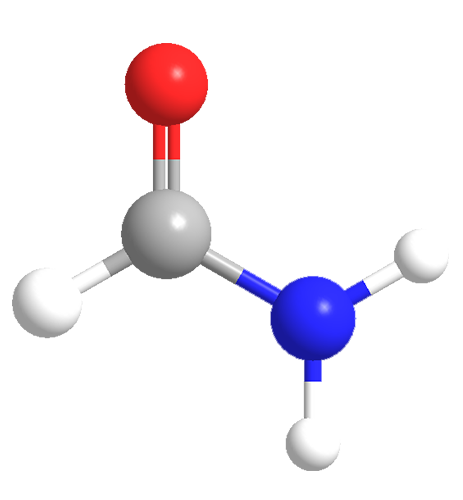

Formamide, the simplest carboxylic acid amide, is a viscous, odorless, colorless liquid with a melting point of 2 ºC and a boiling point of 210 ºC. When it is heated to 180 ºC at atmospheric pressure, however, it begins to decompose into carbon dioxide and ammonia.
In 1920, K H. Meyer and L. Orthmer discovered that formamide can be produced by heating CO2 and NH3 under pressure—the reverse of the decomposition reaction. Today, some formamide is still made this way, but the more common process uses the reaction of methyl formate with NH3. Byproduct methanol is treated with carbon monoxide to produce additional methyl formate.
Formamide is used as a feedstock in the manufacture of formate esters, as an ionizing solvent, as an RNA stabilizer in gel electrophoresis, and in tissue preservation. More intriguingly, it may be a key compound in the origin of life on Earth.
In 2014, chemist S. Civiš and co-workers at the Central European Institute of Technology (Brno, Czech Republic) simulated asteroid and meteor collisions by bombarding formamide and clay with a powerful laser. They produced (among many other compounds) guanine, adenine, cytosine, and uracil—the four nitrogen bases that make up DNA. Formamide is found in great quantities throughout the observable universe, giving credibility to the idea that life on Earth could have originated outside the planet.
MOTW update:
September 25, 2023
Formamide1 is the simplest carboxylic acid amide and is made commercially via the reaction of methyl formate with ammonia. It is found widely in outer space.
In August, Tuğçe Beyazay, William F. Martin, and Harun Tüysüz* at the Max Planck Institute for Coal Research (Mülheim an der Ruhr) and the University of Düsseldorf (both in Germany) described a simple way to synthesize formamide. Under mild, hydrothermal conditions, they passed carbon dioxide and water over Ni–Fe nitride heterostructures, which act as both a catalyst and a nitrogen source. No yield data were reported, but the authors stated that under optimized conditions, significant quantities of formamide and formic acid were produced.
1. CAS Reg. No. 75-12-7.

Learn more about this molecule from CAS, the most authoritative and comprehensive source for chemical information.
Molecule of the Week needs your suggestions!
If your favorite molecule is not in our archive, please send us a message. The molecule can be notable for its current or historical importance or for any quirky reason. Thank you!
Stay Ahead of the Chemistry Curve
Learn how ACS can help you stay ahead in the world of chemistry.

